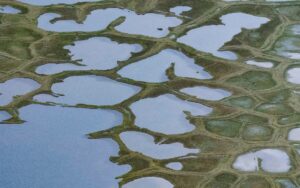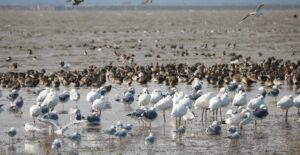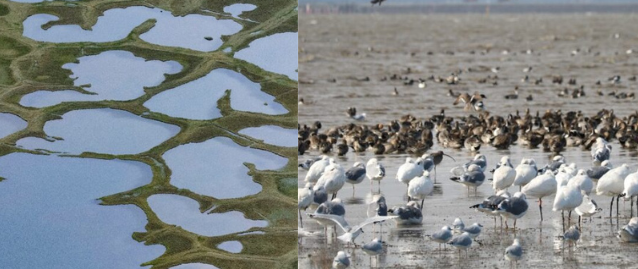On 8th February, 2023, the Government of Saga City, Japan and the Bureau of Land Management (BLM)-Alaska signed the Memorandum of Understanding (MoU) establishing a Sister Site relationshipbetween Flyway Network Sites Higashiyoka-higata (EAAF 124) of Japan and Qupałuk (EAAF 133) of U.S.A. The agreement promotes closer collaboration on conserving migratory waterbirds. A virtual signing ceremony was held, with Mr. Hidetaka Sakai, Mayor of Saga City, and Mr. Steve Cohn, Alaska State Director, BLM signing the MoU.
 ©Saga City, Japan |
 ©BLM |
Both Flyway Network Sites (FNSs) are important for migratory shorebirds, especially for Dunlin (Calidris alpine articola), which is the most abundant shorebirds in Japan, and Qupałuk is high quality nesting habitat. Under the EAAFP Flyway Site Network, the Sister Site Agreement encourages the two FNSs to cooperate in research and monitoring of species of common and their habitats, allow information exchange on conversation and habitat management. In addition, the agreement includes efforts on CEPA (Communication/Capacity Building, Education, Participation, and Awareness) activities to enhance exchange between the sites.
Mr. Steven Cohn, State Director of BLM-Alaska expressed, "As managers of valuable nesting habitat, it is important for the BLM to collaborate with partners throughout the flyway to support holistic habitat management through the full life cycles of species. We look forward to this partnership with Saga City to coordinate on bird monitoring, habitat management, and education and outreach."
Mr. Hidetaka Sakai, Mayor of Saga City, said, “I am delighted that we could establish this Sister Site partnership. The sites are not just essential for the migratory birds, but for our livelihoods as well, and in order to conserve them, it is necessary to have initiatives that go beyond borders. Through this sister site partnership, we will encourage people to think and act on a global scale regarding their conservation and sustainable use. I have high hopes that our efforts will lead to a prosperous future.”
Dr. Keiichi Nakazawa, Director of Wildlife Division, Nature Conservation Bureau, Ministry of the Environment, Japan emphasized, “Higashiyoka-higata became the 33rd Flyway Network Site in Japan in 2016, and it is one of Japan's most prominent migratory stopover and wintering sites for waterbirds, including endangered species such as Saunders’s gull, Black-faced spoonbill, and Common shelduck; making a treasure trove of biodiversity. We are very pleased that Qupałuk and Higashiyoka-higata have concluded the Sister Site Agreement under the EAAFP, and we would also like to express our sincere respect for the conservation efforts made to date. Our ministry will continue to support initiatives conducted for the migratory waterbird conservation between the two wetlands.”
Qupałuk is located in the northeast of Teshekpuk Lake in the northeast corner of the National Petroleum Reserve in Alaska on the Arctic Coastal Plain in Alaska, U.S.A. The site covers over 21,000 hectares of near-pristine tundra, wetland, and open water habitat. Qupałuk hosts approximately 30,000 total nesting migratory birds and is an important habitat for molting geese and eiders. The site is home to a high density of nesting Dunlin, with an estimated population of 6,000. It is the second Flyway Network Site in the U.S.A and is the first managed by the Bureau of Land Management-Alaska. To the Iñupiat people, the Alasak Natives who have lived harmoniously on this land for millenia, Qupałuk means “small shorebird”.

Qupałuk © Kiliii Yuyan
Located on the northern shore of the Ariake Sea in Japan, Higashiyoka-higata has the largest remaining area of tidal flats in the country. The 218-hectare mudflat regularly supports 1% of the flyway population of Endangered Black-faced Spoonbill and Vulnerable Saunders’s Gull, and more than 10,000 migratory waterbirds visit the site annually. Higashiyoka-higata was also designated as a Ramsar Site in 2015. The area used to be called Daijugarami and the traditional knowledge, techniques and food culture were retained and passed on for many generations.

Higashiyoka-higata © Saga City, Japan
The EAAFP Flyway Site Network was established to ensure a network of internationally important sites is sustainably managed to support the long-term survival of migratory waterbirds within the EAAF. To date, there are 152 Flyway Network Sites in EAAF. Under this network, the EAAFP Sister Site agreement offers a mechanism for Flyway Network Sites to collaborate closely on monitoring and research, capacity-building, sharing and exchanging information and experiences, and CEPA activities. Guidelines for the EAAFP Sister Site Program will be adopted during MOP11.
More information
- Flyway Site Network: https://www.eaaflyway.net/the-flyway/flyway-site-network/
- Sister Site Programme: https://www.eaaflyway.net/sister-sites/
Further reading
https://alaskausfws.medium.com/a-little-birds-big-sisters-e071dfe57eac





